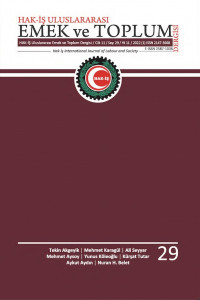GÖNÜLLÜ OLMAYAN KISMİ SÜRELİ İSTİHDAMIN BELİRLEYECİLERİ: HANE HALKI İŞGÜCÜ VERİLERİ ÜZERİNE BİR ARAŞTIRMA
gönüllü olmayan kısmi süreli istihdam, eksik istihdam, esnek çalışma, kısmi süreli çalışma
PREDICTORS OF INVOLUNTARY PART-TIME EMPLOYMENT: A STUDY ON HOUSEHOLD LABOR FORCE DATA
___
- Barrett, G. F. and Doiron, D. J. (2001). Working part time: By choice or by constraint. The Canadian Journal of Economics, 34(4), 1042-1065.
- Bhula-or, R. and Yukio, I. (2014). Factors affecting involuntary part-time employment in OECD countries. Review of Integrative Business and Economics Research, 3(2), 333–349.
- Borowczyk-M., Daniel and Lale, Etienne (2018). The Welfare effects of involuntary part-time work. Oxford Economic Papers, 70(1), 183–205.
- Buddelmeyer, Hielke, Mourre, Gilles and Ward, Melanie (2004). The Determinants of part-time work in EU countries: empirical investigations with macro-panel data (IZA Discussion Paper No. 1361), Institute of Labor Economics, Bonn: Germany.
- Caputo, R. K. and Cianni, M. (2001). Correlates of voluntary vs. involuntary part-time employment among US women. Gender, Work and Organization, 8(3), 311–325.
- De Anda, R. M. (1987). Determinants of involuntary part-time work among Chicanos [Unpublished doctoral dissertation]. University of Arizona.
- Dunn, M. (2018). Who chooses part-time work and why? Monthly Labor Review, U.S. Bureau of Labor Statistics. [https://doi.org/10.21916/mlr.2018.8], (Erişim: 16.12.2018).
- European Union. (2011). Education, science and culture statistics. Luxembourg: Population and Social Conditions Collection Pocketbooks.
- Eurostat. (2022). Involuntary part-time employment as percentage of the total part-time employment, by sex and age. Eurostat Labor Statistics, [https://ec.europa.eu/Eurostat] (Erişim: 05.04.2022).
- Eymen, U. E. (2007). SPSS kullanma klavuzu (e-baskı). İstanbul: İstatistik Merkezi Yayın (No: 1).
- Görmüş, A. ve Erdoğan, Ç. (2017). Türkiye’de gönülsüz kısmi süreli çalışmanın lojistik regresyon modeli ile analizi: hane halkı işgücü anketinden bulgular. Balkan Sosyal Bilimler Dergisi, 6(12) , 150-164.
- Fagan, Colette, Norman, Helen, Smith, Mark and Menendez, Maria C. Gonzalez (2014). In Search of Good Quality Part-Time Employment (ILO Conditions of Work and Employment Series No. 43), International Labour Organization, Geneva: Switzerland.
- Fialova, K. (2017). Part-time employment and business cycle in central and eastern Europe. Review of Economic Perspectives, 17(2), 179-203.
- Kjeldstad, R. and Nymoen, E. H. (2009). Part-time work, underemployment and gender: worker versus job explanations (SN Discussion Paper No. 602), Statistics Norway, Oslo: Norway.
- Leppel, K. and Clain, S. (1993). Determinants of voluntary and involuntary part-time employment. Eastern Economic Journal, 19(1), 59–70.
- Maurizio, R. (2016). Non-standard forms of employment in Latin America: Prevalence, characteristics and impacts on wages (ILO Conditions of Work and Employment Series No. 69), International Labor Organization, Geneva: Switzerland.
- Muller, C. (2010). Underemployed women: an analysis of voluntary and involuntary part-time wage employment in South Africa (UKZN Working Paper No. 185), University of KwaZulu-Natal, KwaZulu-Natal: South Africa.
- Singapore Ministry of Manpower (2021). Singapore manpower statistics in brief 2021, [https://stats.mom.gov.sg/], (Erişim: 11.05.2022).
- Statistics Canada. (2020). An exploration of work, learning, and work-integrated learning in Canada using the longitudinal and international study of adults. [www150.statcan.gc.ca], (Erişim: 11.05.2022).
- Statistics Canada. (2022). Part-time employment by reason, annual. Statistics Canada Labor Statistics. [www150.statcan.gc.ca], (Erişim: 05.04.2022).
- TÜİK. (2018). 2017 Hane halkı işgücü istatistikleri, [www.tuik.gov.tr], (Erişim: 05.04.2022).
- U.S. Bureau of Labor Statistics. (2021). Employment and unemployment among youth—Summer 2021. News Release, August 18, 2021, U.S. Bureau of Labor Statistics, [www.bls.gov], (Erişim: 11.05.2022).
- U.S. Bureau of Labor Statistics. (2022). Employed and unemployed full- and part-time workers by age, sex, race, and Hispanic or Latino ethnicity 2021”, U.S. Bureau of Labor Statistics, [www.bls.gov], (Erişim: 05.04.2022).
- Valletta, R. G., Bengali, L. and van der List, C. (2018). Cyclical and market determinants of involuntary part-time employment (Working Paper No. 2015-19), Federal Reserve Bank of San Francisco, San Francisco: US.
- Veliziotis, M., Matsaganis, M.and Karakitsios, A. (2015). Involuntary part-time employment: perspectives from two European labour markets (EU Improve Working Paper No. 15-02), European Union, Brussels: Belgium..
- ISSN: 2147-3668
- Başlangıç: 2012
- Yayıncı: Hak-İş (Hak İşçi Sendikaları Konfederasyonu)
ILO’NUN KATILIMCI TOPLUMSAL CİNSİYET EŞİTLİĞİ DENETİMİ VE ÖRGÜTLERİN KURUMSAL YAPILARINA ETKİLERİ
PİYASA EKONOMİSİNDEKİ EKONOMİK DAVRANIŞLARDA İNSAN RASYONELLİĞİ VE SOSYAL DEĞERLER
ALMANYA’DA SOSYOLOJİNİN DOĞUŞUNDA İLK (YAHUDİ) KADIN SOSYOLOGLARIN YERİ VE ÖNEMİ
Ali SEYYAR, Mehmet AYSOY, Yunus KÖLEOĞLU
SENDİKALAR VE İŞ GÜVENCESİ: GÜVENCESİZ SENDİKACILIĞA DOĞRU MU?
